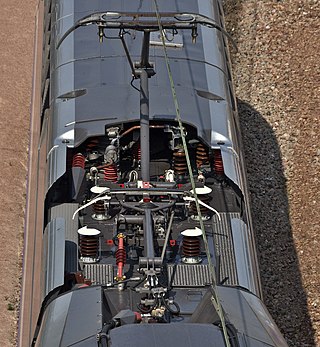
Rail transport is a means of transport using wheeled vehicles running in tracks, which usually consist of two parallel steel rails. Rail transport is one of the two primary means of land transport, next to road transport. It is used for about 8% of passenger and freight transport globally, thanks to its energy efficiency and potentially high speed.

A train is a series of connected vehicles that run along a railway track and transport people or freight. Trains are typically pulled or pushed by locomotives or railcars, though some are self-propelled, such as multiple units. Passengers and cargo are carried in railroad cars, also known as wagons. Trains are designed to a certain gauge, or distance between rails. Most trains operate on steel tracks with steel wheels, the low friction of which makes them more efficient than other forms of transport.

TT scale is a model railroading scale at 1:120 scale with a Track gauge of 12 mm between the rails. It is placed between HO scale (1:87) and N scale (1:160). Its original purpose, as the name suggests, was to make a train set small enough to assemble and operate on a tabletop.

The Association of American Railroads (AAR) is an industry trade group representing primarily the major freight railroads of North America. Amtrak and some regional commuter railroads are also members. Smaller freight railroads are typically represented by the American Short Line and Regional Railroad Association (ASLRRA), although some smaller railroads and railroad holding companies are also members of the AAR. The AAR also has two associate programs, and most associates are suppliers to the railroad industry.

Green Cargo AB is a Swedish state-owned logistics company transporting various types of goods by train. It was created on 1 January 2001 out of the logistics division of Swedish State Railways (SJ). While organised as a public limited company, it is wholly owned by the Swedish government. As of 2019, it was responsible for almost 80% of Swedish rail freight transport.
Brush Traction was a manufacturer and maintainer of railway locomotives in Loughborough, England whose operations have now been merged into the Wabtec company's Doncaster UK operations.

H.K. Porter, Inc. (Porter) manufactured light-duty railroad locomotives in the US, starting in 1866. The company became the largest producer of industrial locomotives, and built almost eight thousand of them. The last locomotive was built in 1950, but the company continues to produce industrial equipment to this day.

A coupling or coupler is a mechanism, typically located at each end of a rail vehicle, that connects them together to form a train. The equipment that connects the couplers to the vehicles is the draft gear or draw gear, which must absorb the stresses of the coupling and the acceleration of the train.

The Victorian Railways (VR), trading from 1974 as VicRail, was the state-owned operator of most rail transport in the Australian state of Victoria from 1859 to 1983. The first railways in Victoria were private companies, but when these companies failed or defaulted, the Victorian Railways was established to take over their operations. Most of the lines operated by the Victorian Railways were of 5 ft 3 in. However, the railways also operated up to five 2 ft 6 in narrow gauge lines between 1898 and 1962, and a 4 ft 8+1⁄2 instandard gauge line between Albury and Melbourne from 1961.

Rail freight transport is the use of railways and trains to transport cargo as opposed to human passengers.

Prima is a family of railway diesel and electric locomotives built by Alstom. Manufacture of the type commenced in the late 1990s. By 2008, Alstom had reportedly sold 1,750 Prima locomotives. The second generation Prima II was launched in 2009. The Prima H3 diesel/battery hybrid locomotive was launched in 2013.

Dieselisation is the process of equipping vehicles with a diesel engine or diesel engines.

The N Class are a class of diesel locomotives built by Clyde Engineering in Somerton for V/Line between 1985 and 1987.

Ferrocarriles de Cuba (FCC) or Ferrocarriles Nacionales de Cuba, provides passenger and freight services for Cuba.

The Eurorunner family of locomotives are a series of medium- to high-power diesel-electric locomotives built by Siemens for the European market. Introduced from 2002 onwards, they share design characteristics with the successful Eurosprinter range of electric locomotives, also built by Siemens.

The Stadler Eurolight is the brand name for a family of 4-axle Bo'Bo' mainline diesel-electric locomotives with sub-20-tonne axleloads for passenger and freight trains produced by Stadler Rail.

Faiveley Transport, formerly Faiveley, is an international manufacturer and supplier of equipment for the railway industry founded in 1919. It introduced the single-arm pantograph in 1955. The company has subsidiaries in more than 24 countries. The majority of Faiveley Transport's outstanding stock is owned by Wabtec, which acquired majority stock ownership from the Faiveley family in 2016.
Etihad Rail DB was a heavy-rail Operations & Maintenance (O&M) service provider in the UAE. The company was set up in 2013 as a joint venture between Etihad Rail (51%), the developer of the UAE's national railway network and Deutsche Bahn (DB) (49%), Europe's largest railway operator and infrastructure owner. Etihad Rail DB was responsible for the operations and maintenance of Stage One of the UAE's national railway network for Etihad Rail’s primary customer, the Abu Dhabi National Oil Company (ADNOC). Etihad Rail DB concluded an Operations & Maintenance (O&M) Agreement with Etihad Rail in August 2013.

The Passenger Rail Agency of South Africa Class Afro 4000 of 2014 is a South African diesel-electric locomotive.

The Transnet Freight Rail Class 23E of 2017 is a South African electric locomotive.

















